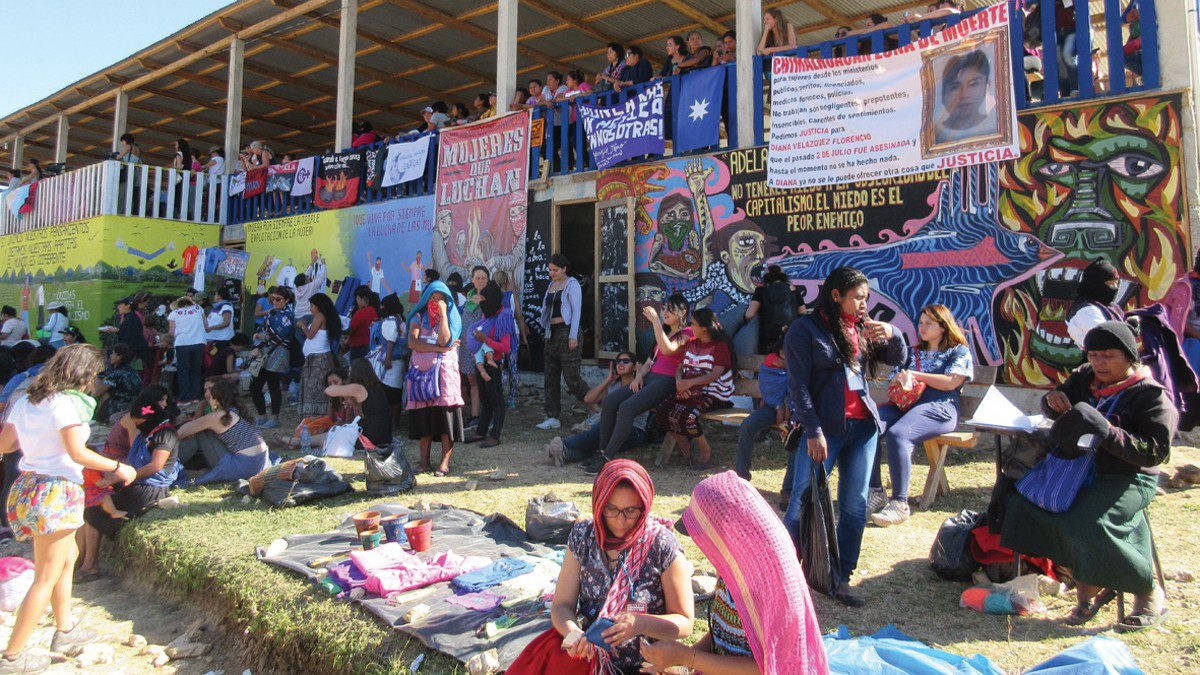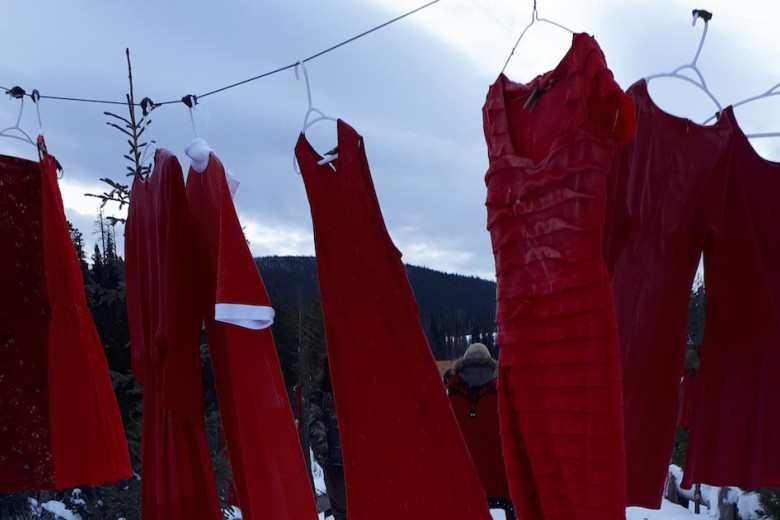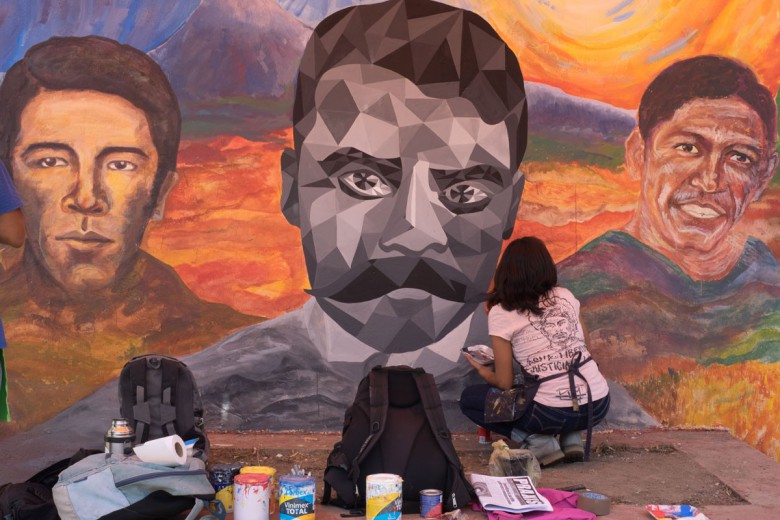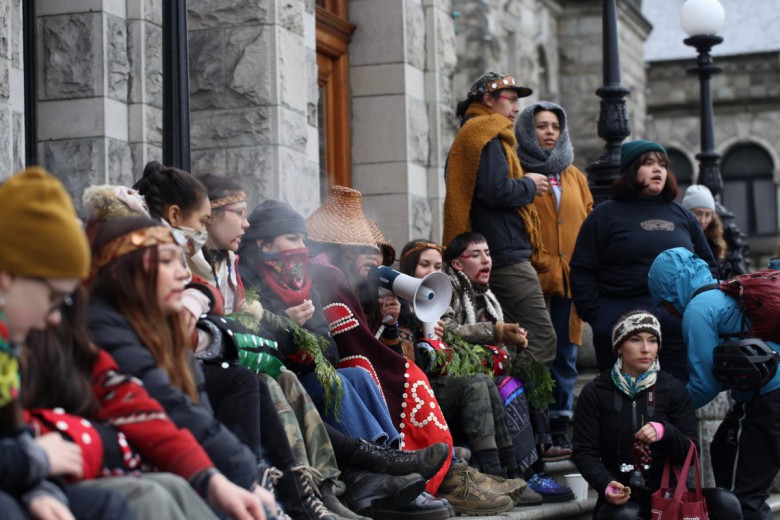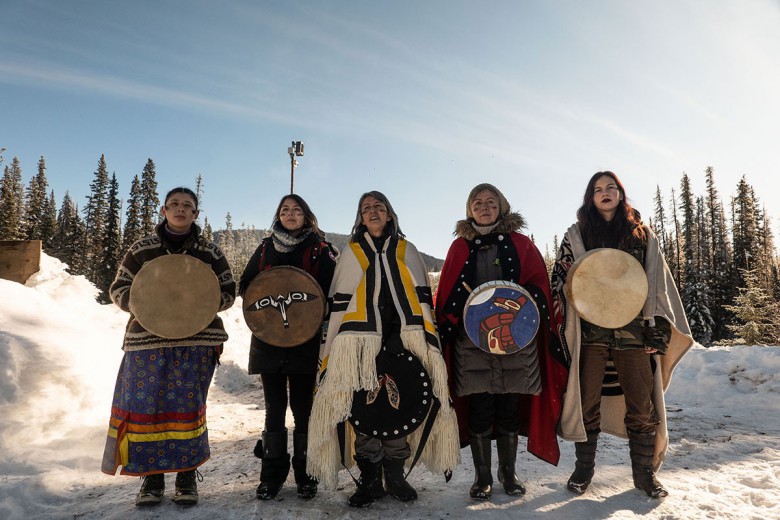The Spanish sign on the side of the hill doesn’t mince any words: “You are in Zapatista autonomous territory. Here the people lead, and the government obeys.”
That sign welcomes us into the Caracol of Morelia in Chiapas, Mexico, for the First International Gathering of Women in Struggle, held over five days in March 2018. I am one of over 5,000 (self-identified) women activists from around the world, hosted by over 2,000 Zapatista women from across their territory, who have travelled here to share our struggles. Some of the women I’m travelling with are Indigenous land defenders and culture keepers from North America; others are the children and grandchildren of Latin American migrants who were displaced from their homes by the very forces the Zapatistas have been fighting against for three decades; still others are activists like me, descendants of European invaders on Turtle Island looking for some way out of the destructive culture that our predecessors built. Could what the Zapatistas have created show us a way to do that? I’m here to see for myself.
A poetics of revolution
The Zapatistas burst onto the international scene on January 1, 1994, the day that the NAFTA agreement took force, when their armed uprising seized several towns and cities in the southernmost state of Mexico. But for more than a decade before, the Zapatistas had been slowly building a clandestine movement to reassert the dignity and autonomy of their communities.
Today they control about a third of the territory of Chiapas, with an unknown population that likely totals somewhere around 300,000. There are also communities and supporters in the surrounding states, many of them living and organizing at various levels of the same clandestino movement that began here, in its highland heartland. The Zapatistas don’t generally give out their names, and they wear their masks at all times to protect their anonymity. “Our words are collective,” says one compañera, “so our identities don’t matter.”
“Our words are collective,” says one compañera, “so our identities don’t matter.”
Being opposed as they are to universals, the Zapatistas’ foundational beliefs are hard to pin down in a way that can be maddening to outsiders. Theirs has always been a movement of poetics and myth as much as military tactics. At the Encuentro, the gathering, I heard a story of the enigmatic spokesperson formerly known as Subcomandante Marcos that shows some of that poetics. Like so many Zapatista stories, it may or may not be true; its mythos is its power. During the clandestine times, when the insurgents were always being hunted, Marcos and several other insurgents were riding their horses through the jungle. Coming down the road was a group of women, walking with the sun behind them. Unable to see their faces, the insurgents wondered if they were friends or foes – but Marcos looked ahead and said, “Those women are hermanas, sisters. They are with us.” Surprised, the other insurgents asked him how he could tell just from their silhouettes in the dawn light. “By the way they walk,” he says. The dignity in their stride – among a people so oppressed by colonialism and patriarchy that one compañera told us that, before the uprising, Indigenous women would be given away for a case of beer – was their mark of being Zapatistas. After spending just a few days among these women, I know what he means. I could feel their collective strength just being in their territory, sharing in this small part of the world they’ve built for themselves. The power of that dignity shaped everything that happened at this gathering, and it’s the thing that I’ll carry with me more than anything else I experienced there.
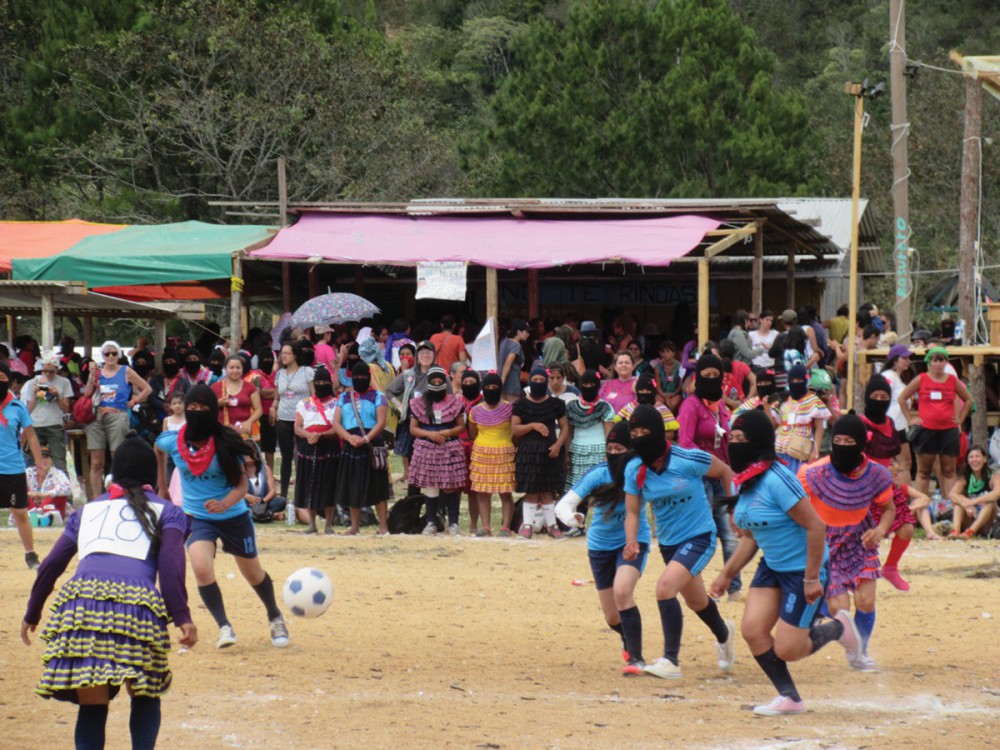
A different kind of politics
It’s a significant time for the Zapatistas to hold such a gathering. María de Jesús Patricio Martínez – affectionately known as Marichuy – was elected as the spokesperson for the National Indigenous Congress (CNI), and is the first Indigenous woman to attempt a run for president. Her candidacy was mistakenly interpreted by many as a shift in the Zapatistas’ tactics, toward more institutional forms of power. Many people in Mexico, as well as abroad, reported that Marichuy’s candidacy was the Zapatista Army of National Liberation (EZLN) running a candidate in the elections, a falsehood that was roundly put down in a communiqué released in November 2016. “For the politicians above, across the political spectrum,” reads the communiqué, “there will always be a foreign enemy behind indigenous peoples. […] The EZLN has not ‘altered its course’ to any degree, nor has it reoriented its struggle to the institutional electoral path.”
“There will always be a foreign enemy behind indigenous peoples.”
That misunderstanding demonstrates how little the broader public in Mexico understands the Zapatistas and their relationship with the CNI. Liz, a student from Mexico City, came to the gathering to learn for herself about the Zapatistas. “People in the rest of Mexico don’t understand what’s happening here,” she tells me. “They don’t know what the people here have built. They only see what’s in the media, they only see guerrillas, violence. They say, ‘Why are those Indigenous people always causing trouble?’”
The Zapatistas’ struggle against what they call the gobierno malo, the bad government – the entire system of non-Indigenous governments whose task is to administer capitalism – is not just a struggle of ideology and opinion. The EZLN is still an army, and for good reason. Just a handful of weeks before the gathering, fighting erupted again in the small town of Oxchuc, on the edge of Zapatista-controlled territory, which has been the site of an almost year-long struggle between the Indigenous population and the paramilitary supporters of the governing mayor and council. As we drove through Oxchuc on the way to the gathering, our van had to navigate around the remnants of roadblocks that had been erected during the conflict.
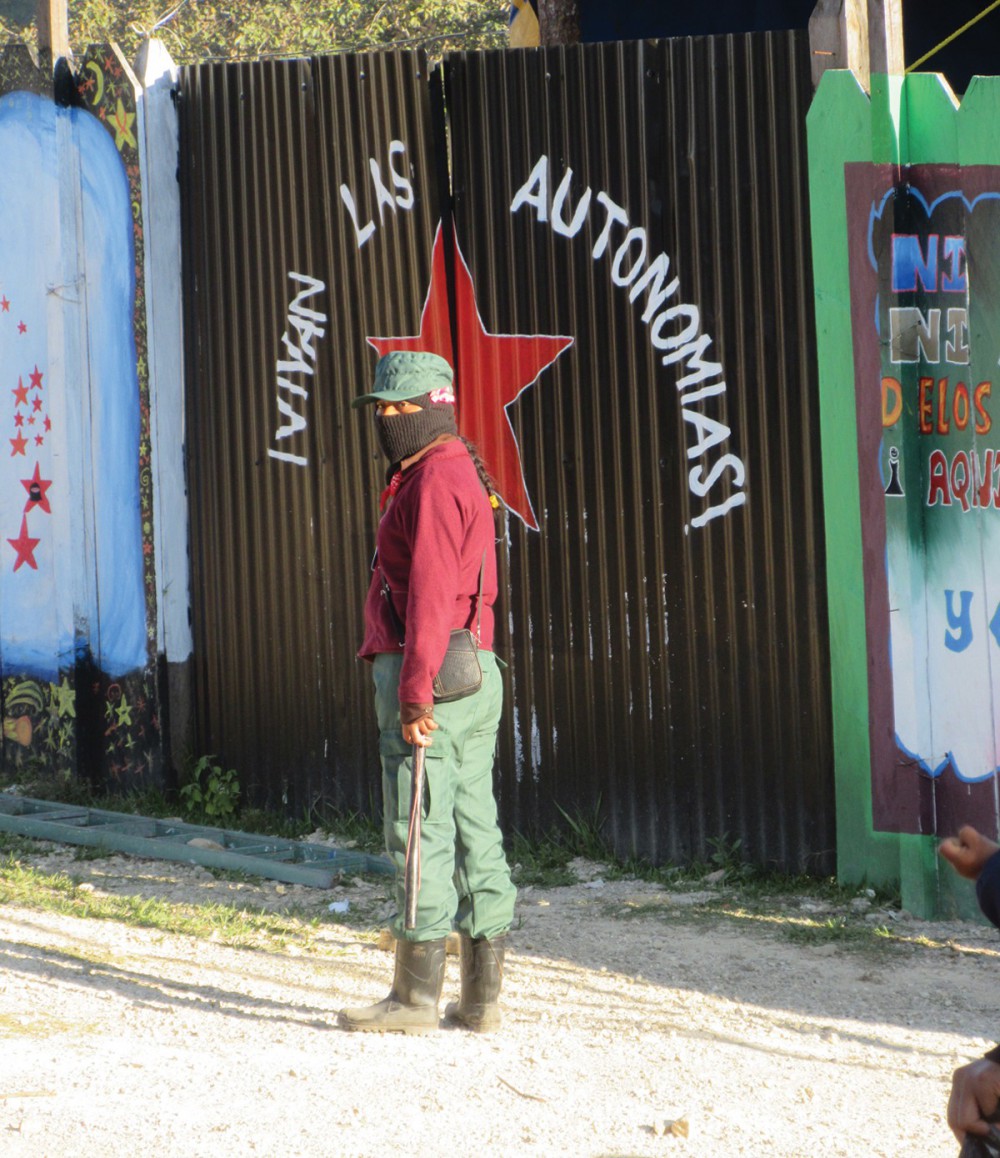
On the international political stage, too, there are events in motion with deep implications for the Zapatistas’ struggle. Amid the current negotiations to “modernize” NAFTA, as well as Trump’s storms of tweet-threats to rip it up, the agreement’s future seems uncertain.
Many civil society groups in Canada, the U.S., and Mexico are demanding three major reforms to NAFTA: remove all references to water as a tradable commodity; end the investor–state dispute resolution mechanism, which allows the private sector to sue state entities for lost profits due to regulations; and protect the rights of Indigenous peoples. Trudeau’s Liberal government has reportedly introduced an Indigenous rights chapter to the negotiations, and while they solicited input from Indigenous organizations, few outside of government and the negotiating team have seen the draft.
These three priorities – water, Indigenous rights, and limiting corporate power to set policy and control resources – mirror the broad shape of struggles that were represented at the gathering. During the course of the event, hundreds of workshops and report-backs were offered by visiting women from all over Latin America and the world. Many of the struggles they came to talk about were the sort of mythological, David-and-Goliath clashes that echo across Turtle Island: Indigenous and peasant communities resisting dams, highways, and land grabs (usually facilitated by industrial agriculture); fighting to stop mines whose parent companies have office towers in downtown Vancouver and names on buildings at Canadian universities. Again and again in these struggles, just like here at home, it is Indigenous communities which are on the front lines. And just like here at home, those who are made the most vulnerable in those communities are the women.
Struggle begins with land
In many Latin American countries, most of the women live by working the land, in the peasant agricultures that feed their communities. “Peasant agriculture improves the land,” says Tamara Ortiz-Ávila, a Mexican agro-ecologist and peasants’ rights advocate. “The water, the soil, all of the land is restored by working it in the traditional way.” During her presentation on peasants and agro-ecology, she talked about peasant communities that have cultivated their lands for generations without depleting the soil or water. But when industrial agriculture moves in, the land is exhausted within a few years, making traditional lifeways impossible.
These three priorities – water, Indigenous rights, and limiting corporate power to set policy and control resources – mirror the broad shape of struggles that were represented at the gathering.
Under agreements such as NAFTA, peasants have lost access to their lands in favour of export-focused agribusinesses. Ortiz-Ávila gave the example of women she’s worked with in Michoacán, where over 100,000 hectares of avocados are produced for export. The diverse agriculture of the peasants has been displaced by international agribusiness operations. “So now,” says Ortiz-Ávila, “the women there can’t access any land to grow their own food.”
The loss of this agriculture, and the displacement of Indigenous peoples more generally, puts women particularly at risk. Women lose their wealth and their place in the community when their traditional provisioning work is lost, and sexism in the workforce means that they are often excluded from the wage economy that replaces it. Not able to access waged employment or to support their families in the traditional way, many of these women are forced to migrate off their lands into urban areas, or – more dangerously – across country borders.
Women lose their wealth and their place in the community when their traditional provisioning work is lost.
Speaking on the same panel as Ortiz-Ávila, Anita Clerida, a migrant rights activist working in Chiapas, asks the 40 or 50 people in the room to put up our hands if we know someone who is a migrant. Every hand in the room goes up, a chilling reminder of the scope of the migration crisis throughout Latin America. It’s much more difficult for women migrants to find work than it is for men, making their lives especially precarious. Women often migrate to escape domestic violence, hoping for refugee status in the U.S. and Canada, find that they don’t meet the criteria or can’t gather the proof necessary to qualify. Additionally, women migrants often face gendered violence at the hands of police and immigration officers, and are unable to access domestic violence services if they are living without status in their new country of residence. It is simply not known how many people disappear trying to migrate through Mexico, but many thousands of them are displaced Indigenous women. To me, the disappearances hauntingly echo the crisis of missing and murdered Indigenous women here in Canada.
Many of these dynamics of displacement and migration have their roots in agreements like NAFTA, which enshrine neoliberalism in Latin American economic policy. I asked Clerida how these connections work. “These [trade agreement] negotiations only concern commercial interests,” says Clerida. “For example, there are many provisions in NAFTA for developing Mexico’s agriculture – but it is all industrial agriculture. There is nothing there about the agriculture of the campesinos, no protection for peasant agriculture.” Without that protection, so-called “development” only intensifies the displacement of Indigenous and peasant communities.
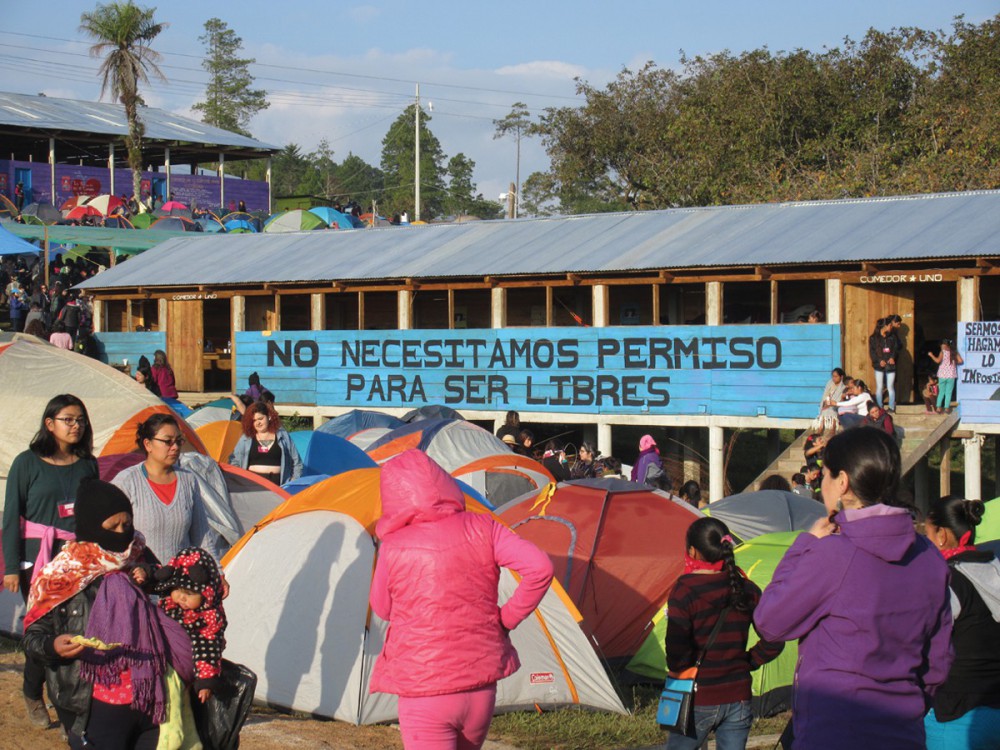
Clerida also points out that, as part of many of these agreements, billions of U.S. dollars have poured into southern Mexican states like Chiapas for immigration policing, effectively making Mexico’s border with Guatemala an extension of the U.S.–Mexico border. I saw it for myself in Chiapas, where highways are diverted through fenced and guarded immigration checkpoints that feel like driving into a jail. Every vehicle must pass through; each is photographed and boarded by armed immigration officials. As a result of this militarization of immigration policing, Clerida tells me that more Central American migrants are deported from Mexico now than from the U.S. Is there anything in the current NAFTA renegotiations to recognize how its neoliberal basis contributes to the migrant crisis and to elevate the rights of migrants in any way? “_Nada_,” says Clerida. Nothing.
So if the neoliberal policies that are enshrined in agreements like NAFTA are so harmful to these communities, would it be better if the agreements collapsed completely, as Trump has postured that they might? Mexican activist Carmen Méndez Trejo tells me it’s not that simple. “Here in Mexico, for two decades everything has been affected by these agreements.” This has entrenched neoliberal policies at all levels of government. Water rights are a good example: due to the provisions of agreements like NAFTA, it’s often the case that corporations have more rights to the water in a community than the people who live there. In Baja California, for example, local communities are fighting to stop the construction of a giant bottling facility by Constellation Brands, the parent company of Corona beer, which they fear will suck the already arid Mexicali Valley dry.
To me, the disappearances hauntingly echo the crisis of missing and murdered Indigenous women here in Canada.
Citing this example, where the state government signed the deal with Constellation without consulting the residents, Méndez Trejo points out that state and local governments have no interest in making things better for communities, even if the trade agreements collapsed. “Their neoliberal politics are only concerned with creating benefits for the private sector,” she says. “The concerns of the campesinos are to recover their land and their territory and their own way of working.” She believes that it is the capacity of local communities to resist the power of the private sector that will decide their fate – after three decades, thoroughly “NAFTA-ized” governments aren’t going to do it for them.
The wellspring of resistance
The question that brought me to Chiapas in the first place was: what is the secret of the Zapatistas’ success? Facing displacement and capitalist exploitation, how have they been able to hold on to their territory and their revolution for more than two decades?
Through collective work to yield food, water, shelter, safety, health care, education, and everything else their communities need, the Zapatistas have found a way to provide for themselves outside of capitalism – a set of social relations that many of us cannot even imagine. Many of the Zapatista women who hosted us for this gathering are in their 20s and 30s. They’ve lived their whole lives in the otro mundo, the other world that we, in our movements here in Canada, always say is possible. But in Chiapas, it’s not just a possibility, it’s the world in which the Zapatistas work, live, and raise their children. The systemo malo, the bad system, doesn’t have control over the daily lives of the Zapatistas. “Our resistance is in cultivating the land,” one compañera tells me. “It’s how we survive.” In their farm collectives, the women who are hosting us grew all the food for the gathering: corn, rice, beans, vegetables, chicken, fruit, and more for 5,000 people, in addition to feeding their own communities and producing extra for sale outside of their territories. Being a farmer myself, I’m awed and humbled at this accomplishment and the work it represents. “We found our dignity in the resistance, with collective work,” says another compañera.
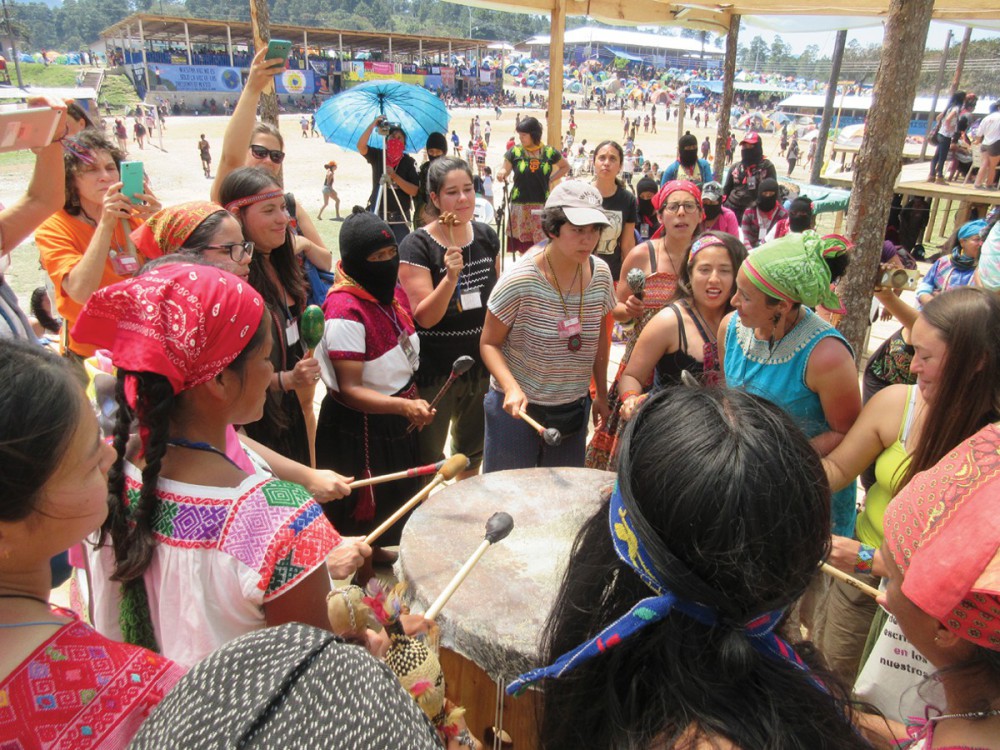
Another reason for their success is the centrality of women in the Zapatistas’ movement. Insurgenta Erika, a Zapatista infantry captain who gave the opening address welcoming us to the Encuentro, talked about the role of women in the rebellion. “I was born and grew up with the military patrols surrounding our communities and roads,” she told us all. She spoke of organizing clandestinely with other Zapatista women – not just making speeches but actually carrying arms and fighting the forces of the Mexican state, with mostly men under their command. “And they obeyed us,” she told us all, “because what mattered wasn’t whether you were a man or a woman but the fact that you were willing to fight without giving up, selling out, or giving in.”
It’s also more than just the ability of Zapatista women to take on the conventionally masculine role of fighting. Feminized work like growing food and caring for children and elders is valued as highly as fighting, and recognized as part of the revolution. One of the artisans who had brought her work to the Encuentro showed me embroidery depicting a masked Zapatista woman working in her garden with a baby – also masked, of course – on her back. “The work of daily life is the wellspring of resistance,” it read. How different, I thought, from movement spaces I’ve been part of in the settler world, where activism is often separated from the rest of life, and the splashiest, most brazen acts get the most credit. When we still depend on the systemo malo to provide for our material needs, how can we help but bring that system’s brokenness with us into our movements?
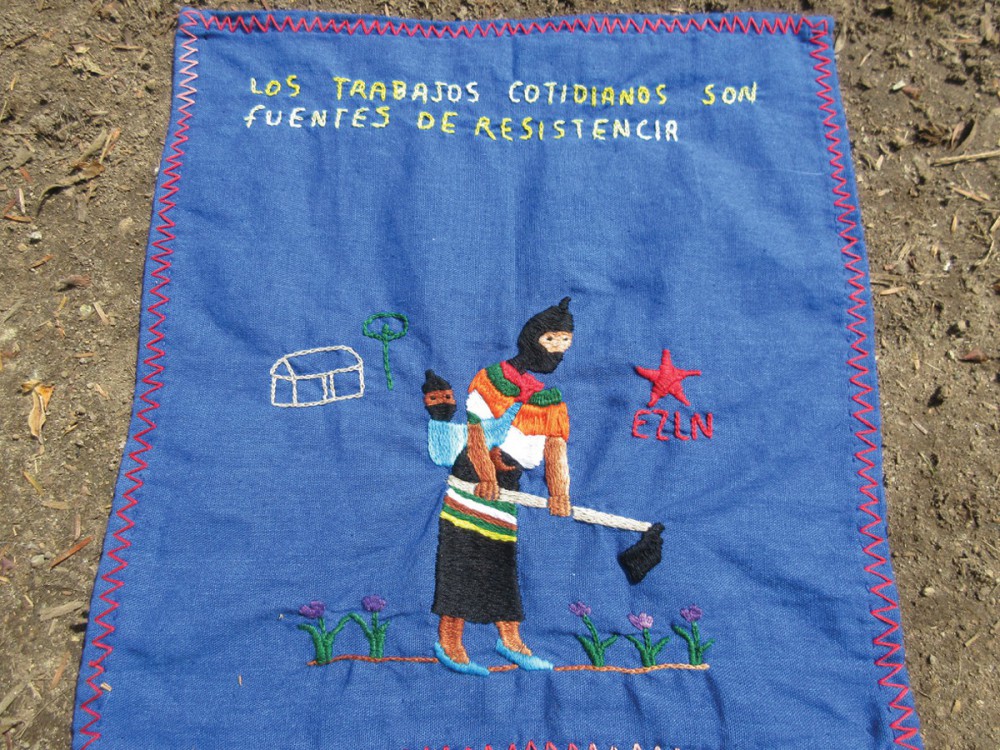
There are exceptions, of course: many Indigenous-led movements in so-called Canada begin from a similar place of culture, of sovereignty – and settlers like me can get behind those movements and learn from them as we learned from the Zapatistas’ generosity during this Encuentro. But the settler world, the dominant culture, has to do more than just let Indigenous folks do the heavy lifting. Settler movements so often try to do our work within the existing social relations of the systemo malo. Grounded in place and focused not on piecemeal reforms but on building an entirely different culture, an entirely different world, the Zapatistas seem to find the strength to hold together in the face of the fiercest opposition. This is a strength that settler movements in the dominant culture desperately need, and that nobody – especially not governments or states – is going to build for us. As one compañera told me, “What the bad government does doesn’t matter. Our resistance continues.”


